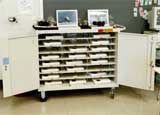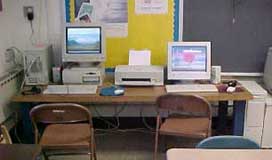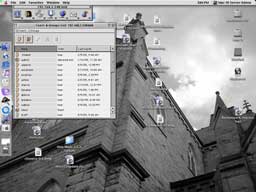|
Steve Wood's
View from the Classroom Computers in the Classroom: |
Over the last few years, I've tried to run at least one column a year about what computers are available to my students and what we do with them. This time around, I'm going to try to do a series of columns about the computers we use, how we've set them up, what we do with our computers and why, and finally, how our student computer take-home project is going.
That situation was only compounded when I discovered Roger Clary's SpellTutor Over the years, a variety of ancient Macs passed through my room, including my incredible Mac IIfx and a Performa 575. A few belonged to the school system, but more were ones I'd procured on eBay. We finished the 2001-2002 school year with my Power Mac 7500/G3, the school's Power Mac 7200/75, two Power Mac 7200/90's, an LC 5200 that I'd upgraded to 100 MHz, a Power Mac 8100/110 cast off from the art room, and a Power Mac 5400/200 that I'd rebuilt from two failed machines. All the machines had received significant RAM and hard drive upgrades. In addition, we had housed the school's Power Mac 8550 server as a file and print server for several years. While students were almost never allowed to use the server, it allowed our classroom network to stay up and running even when the main school server was down.
Then, the real fun began. The grant specified that several carts of wireless laptops were to be purchased for the express purpose of improving writing scores of our elementary students with learning disabilities, and in some cases, regular education kids. Since I was and am the elementary learning disabilities teacher, I got to help specify what hardware and software would be used to fulfill the grant. While our school's "Evil NT Techie" and I have fought platform wars for several years, we were quickly able to amicably spend the booty and quickly settled on a cart of 24 iBooks and another cart of 24 IBM ThinkPads. Since one cart of laptops was to be based in my classroom, I quickly shipped all of the school's Macs, excluding the MacServer, to other special education rooms in the corporation where they remain in use today. (Since we're a one campus K-12 system, that meant rolling the units on carts to the connected jr.-sr. high school building.)
By late July, it became apparent that OS X wasn't yet refined enough to do all that we wanted and not enough software had been recoded to run native in X to suit our requirements. We began the 2002-2003 school year with all of our Macs running OS 9. It wasn't until the end of February that we were finally able to boot all of the iBooks to OS X. Apple fixed several issues in Classic with the 10.2.2 upgrade that allowed us to run several critical applications in the Classic box of OS X. Even then, the accounts feature of 10.2.4 wasn't able to allow us to use separate student and administrator logins. We couldn't get such things as the Launcher to be recognized by the accounts administration panel. All of our AppleScripts from OS 9 that mounted a CD and then launched the appropriate application were also unusable. Had Apple not made its free OS X for Teachers offer, none of the student computers would have run OS X all year. There simply wasn't that kind of money in the tech budget. When my students arrived for the first day of school on August 14, our desktop computers included the 800 MHz G4 tower, a beige G3 266 MHz Minitower I'd picked up the previous winter to back up my home unit, my venerable 7500/G3 250 MHz which shares its monitor, keyboard and mouse via a KVM box with the MacServer, and a 1.4 GHz PC tower equipped with a 17" ELO touchscreen monitor running Windows 2000 Professional. With the cart of 24 iBooks, four desktop units seemed more than adequate. For the first time since I started teaching with computers in the classroom, I reserved my desktop computer for my exclusive use...most of the time:-), so the kids actually only had access to three desktop computers. Moving out several desktop computers also had the advantage of opening up the classroom a bit. Retaining several desktops also served as an alternative for one rather destructive student who had a penchant for tearing keys off laptops.
At the risk of jinxing our class, the kids have been great with the laptops. We emphasized carrying the iBooks with two hands, unhooking the long-corded headset before carrying the units, and have been fortunate not to have "a drop" as yet. Besides losing keys from the keyboard, we've had a number of tips break off from the power supply. Several broke off inside the iBooks, necessitating return to the "local" AppleCare Station for repair. We're currently down to 20 available iBooks, as four are in for service. When the four return, we'll probably need to send in another batch for service of faulty Airport cards. While the older Macs are considerably slower than the rest of the classroom computer complement, each runs a ton of RAM which allows them to function well with most of our applications. The older Macs also have serial printing ports which allows use of a couple of old Epson 850 printers as local printers as long as we stayed with OS 9. Early in the school year, the school techie dropped off a Tektronics Phaser 740 color printer that was on its last legs. While we never got the wireless laptops to recognize the printer, several of the desktop computers did. We used the Phaser on the days it didn't continually jam to run multiple color copies of various assignments and software manuals for the other special education teachers. I also had an Epson C80 printer connected to the G4, but most of the time the terrible Epson drivers and OS X made its use an occasional thing. Had the printer not worked well with the Toshiba laptop, it would have been quickly featured on eBay. My next round of inkjets won't be Epson's. It wasn't until February that we got an HP LaserJet 1200 with a wireless connection so the laptops could print. Until then, completed student assignments were saved to the server and then opened on the G4 to be printed by whichever printer was in a good mood and printing well that particular day. We chose a black and white laser printer over a color inkjet simply because the lasers seem to have a longer lifespan. A color laser printer would have been nice, but was out of our budget.
When we made our computer purchases last spring, the "Evil NT Techie" felt that he needed a good Mac to "administrate" the other Macs. He chose a dual 1 GHz G4 QuickSilver tower and has fallen in love with Mac OS X. Among the goodies he ordered, many at the suggestion of our excellent Apple Education Sales Representative, Jeff Hartman, was a copy of AppleShare 6.3. Since the techie runs OS X exclusively on his tower, I was only too happy to relieve him of the new AppleShare software. It's added a lot of flexibility to our server use, including the ability to lock student folders to students other than the owner.
While I'm getting a bit ahead of myself, we use the server to store student compositions, student PAWS typing files, Co:Writer student files, and a variety of other things. Often, a student's folder (directory) may include a digital photo or two, several spelling assignments, and any number of compositions done during the year. While we easily preserved all of the kids' older writing files in the transition from AppleShare 5 to 6, we almost lost one student's personal journal when Office for Mac locked up and left only a Word Work file in an invisible folder. BBEdit saved the day on that one. There's a separate share point set that is accessible only by staff that carries all of our Macintosh site license software installers, system updates, SpellTutor sound files for a variety of spelling programs, and a lot of cool graphics for staff use. In the "If I had it to over again" category, I've found that 24 laptops for my classroom is a bit of an overkill right now, even with units out for repair. We ordered an ideal number of laptops for our primary and intermediate classrooms, but the cart in my classroom rarely travels further than across the room. Do keep in mind that my classroom is a special education resource room with many levels of students present at the same time. Usually, several students are tied up in direct instruction with my assistant or myself. I do hope to do some whole class lessons at some point and sadly, twenty-four iBooks will just about cover everyone:-(. One thing we didn't order with grant funds was a good projector. At the time of the order, there were several such units around the school, but in the year since the order, all of them have been permanently mounted in classrooms other than ours! Anyone fortunate enough to have a similar purchasing opportunity such as ours might do well to include a computer projector in their plans. It's been an interesting change this year to deal mostly with issues of teaching the OS and applications and fixing glitches and configuration problems from the previous problems of making sure there were enough units to go around. We're certainly "computer rich" this year, and we're making the most of it. While I'll write specifically about how we use our machines in part 3 of this series, just let me say at this point that with primary responsibility for teaching reading to 30 disabled students, my assistant and I have needed all the help we can get. Since we haven't as yet been able to get anyone else hired to help teach our kids, we've employed our computers to fill our students' time not spent with an instructor or with seatwork as beneficially as possible. Related Columns
Send your feedback to
Ads shown on this site do not represent an endorsement or warranty of any kind of products or companies shown. |
All links updated 4/30/2008
©2003 Steven L. Wood
 Nine years ago, we began with a single Macintosh
Nine years ago, we began with a single Macintosh  program and began requiring all my spelling students to use the program daily for drill on their various spelling lists. A few castoff
program and began requiring all my spelling students to use the program daily for drill on their various spelling lists. A few castoff  During the second half of the 2001-2002 school year, our school received an
During the second half of the 2001-2002 school year, our school received an  We chose to order custom carts that hold 24 laptops each to provide enough laptops to cover a regular intermediate classroom with no students having to share laptops. Twenty-three of the iBooks were the (then) base configuration 500 MHz with an upgrade to 256 MHz of RAM and Airport wireless cards. One iBook was the faster 600 MHz model that included a CD-RW burner. After a year, I've found that we rarely use the iBook's burner, as I generally use the Toshiba laptop for duplicating CDs (or an old Compaq 400 at home that is equipped with a fast CD and a faster CD-RW). The custom carts have proved effective and convenient. They're not top heavy, even with the addition of HP LaserJet 1200 printers on top.
We chose to order custom carts that hold 24 laptops each to provide enough laptops to cover a regular intermediate classroom with no students having to share laptops. Twenty-three of the iBooks were the (then) base configuration 500 MHz with an upgrade to 256 MHz of RAM and Airport wireless cards. One iBook was the faster 600 MHz model that included a CD-RW burner. After a year, I've found that we rarely use the iBook's burner, as I generally use the Toshiba laptop for duplicating CDs (or an old Compaq 400 at home that is equipped with a fast CD and a faster CD-RW). The custom carts have proved effective and convenient. They're not top heavy, even with the addition of HP LaserJet 1200 printers on top. I took all of my Macs home for the summer, along with an iBook, the Toshiba laptop, and a dandy new G4 Quicksilver tower that arrived just before the end of the school year. The iBook handled almost all of my computing chores when my wife, Annie, had major surgery at the Cleveland Clinic early in the summer. While I had the Toshiba with us as well, the iBook got most of the service maintaining the Educators' News web site for the weeks we spent in Cleveland (Educators' News archives:
I took all of my Macs home for the summer, along with an iBook, the Toshiba laptop, and a dandy new G4 Quicksilver tower that arrived just before the end of the school year. The iBook handled almost all of my computing chores when my wife, Annie, had major surgery at the Cleveland Clinic early in the summer. While I had the Toshiba with us as well, the iBook got most of the service maintaining the Educators' News web site for the weeks we spent in Cleveland (Educators' News archives:  After returning home from Cleveland in mid-June, I worked at getting Mac OS X to work on our various Macs and with our existing school software. Several software titles also came in for evaluation. While the software end will be left for a future column, I decided that anything we purchased had to be dual platform. Beyond that, I was looking for titles that not only ran under several versions of Windows and Mac OS 9, but I also wanted them to run either native in OS X or at least well in the classic box of OS X. I'll deal in detail with our software in part 3 of this series. However, since I've already published a review on it, I don't think I'm letting the cat out of the bag buy saying we made a major software investment in Don Johnston, Inc.'s
After returning home from Cleveland in mid-June, I worked at getting Mac OS X to work on our various Macs and with our existing school software. Several software titles also came in for evaluation. While the software end will be left for a future column, I decided that anything we purchased had to be dual platform. Beyond that, I was looking for titles that not only ran under several versions of Windows and Mac OS 9, but I also wanted them to run either native in OS X or at least well in the classic box of OS X. I'll deal in detail with our software in part 3 of this series. However, since I've already published a review on it, I don't think I'm letting the cat out of the bag buy saying we made a major software investment in Don Johnston, Inc.'s 



 It seems that I keep mentioning "the server" without ever getting much into it. Our classroom MacServer is a Power Mac 8550 that once served as the school's only server. It came to my classroom after sitting for a year or so after it was relieved of its whole school duties with the request that I set it up as a file and print server for the Macs. We upgraded the RAM to 192 MB and installed what seemed then like an immense 18 gig SCSI Barracuda drive. The server functioned for several years running OS 8.1 and AppleShare 4.1, followed later by AppleShare 5.
It seems that I keep mentioning "the server" without ever getting much into it. Our classroom MacServer is a Power Mac 8550 that once served as the school's only server. It came to my classroom after sitting for a year or so after it was relieved of its whole school duties with the request that I set it up as a file and print server for the Macs. We upgraded the RAM to 192 MB and installed what seemed then like an immense 18 gig SCSI Barracuda drive. The server functioned for several years running OS 8.1 and AppleShare 4.1, followed later by AppleShare 5. I divorced the server from its own monitor and keyboard last year when I bought a Dr. Bott MoniSwitch (KVM). It allowed my desktop computer's mouse, keyboard, and monitor to switch back and forth from my computer to the server. With the addition of the G4 tower (which uses a USB keyboard), the server and KVM box were moved to the corner of the room closest to our Ethernet drop and switch. On the rare occasions when I have to directly access the server, I use the 7500's monitor, keyboard, and mouse. More often, I access the server from the G4 to add users (see screenshot at right), edit files and folders, and to print student work.
I divorced the server from its own monitor and keyboard last year when I bought a Dr. Bott MoniSwitch (KVM). It allowed my desktop computer's mouse, keyboard, and monitor to switch back and forth from my computer to the server. With the addition of the G4 tower (which uses a USB keyboard), the server and KVM box were moved to the corner of the room closest to our Ethernet drop and switch. On the rare occasions when I have to directly access the server, I use the 7500's monitor, keyboard, and mouse. More often, I access the server from the G4 to add users (see screenshot at right), edit files and folders, and to print student work.
